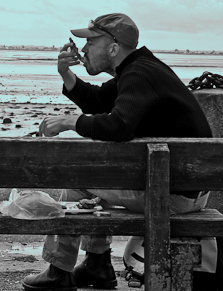Joe Ray
Food & Travel / Words & Photos

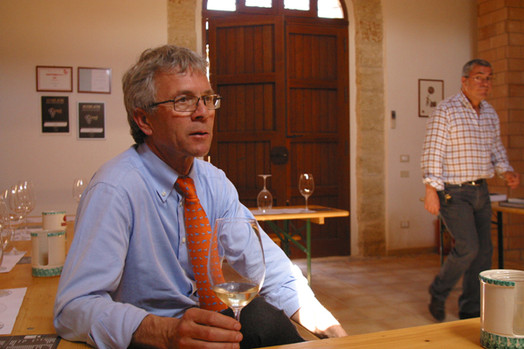
Wednesday, May 09, 2007
The Name On The Bottle
I meet Calogero at his Palermo office, but his heart has already left for the hills.
So we follow.
A lawyer by day and a wine producer whenever he has a spare moment, Calogero Leone runs his vineyard on property his family has owned for some 200 years.
It’s hard to imagine that countryside this beautiful exists so close to Palermo, a city where green space is rare and one of the best-known parks is covered in asphalt.
Though Leone grows and sells enough grapes (without turning them into wine) to employ several people, he only completes the process and puts his name and the vineyard’s – Tenuta Mariano – on 5,000 bottles per year, a paltry five percent of what he grows.
He takes me out into the vines to show me how they are slowly turning the family business from a quantity to a quality production. Several workers are out between the rows, already trimming back a good hunk of the new growth.
“Cutting back like this means we make 50 percent less wine but the quality is better,” he says. “Unfortunately, there isn’t a direct correlation between lower volume and a higher selling price.”
He’s a stickler for quality.
“We started the changeover in 2000 and have had two years where we didn’t produce,” he says.
So… in seven years of existence, there were two years where you bottled no wine?
“It wasn’t good enough.”
Later, as we head to meet a producer/friend of his, I ask why he wanted to make this switch.
The first few minutes of his reply seem to be the Sicilian version of vintner babble, but as we drive through the rapidly changing countryside, he lets me in a bit.
“As you get older, you encounter difficult situations, even pain,” he says. “I now prefer a quality of life that gives value to things.”
We pull into the Ceuso vineyards in Calatafimi Segesta, a small- to mid-sized producer run by the Melia brothers and their geologist brother in law.
“He does the accounting,” clarifies Vincenzo Melia (left), the agronomist.
Vincenzo is clearly distressed by something that happened just before our arrival and his shoulders don’t relax until he opens a bottle of their white wine and its smells (pineapple, most notably) drift across the tasting room.
He picks up on Calogero’s vein of the quality that a smaller producer can give to their wines.
“You can make wine more economically if you’re a big producer,” he says, waving his arms in a mix of exasperation and relief, “but the little producer can make more animated wines that have more soul.
“I prefer to sell my wine with my name on it.”
This is Joe Ray reporting from the Motherland.
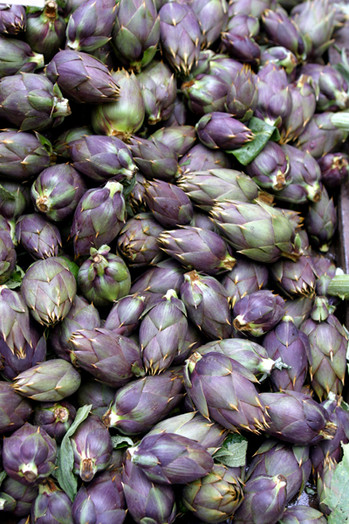
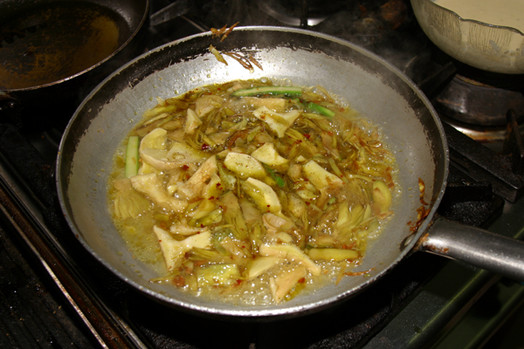
Tuesday, April 24, 2007
Winking At The Matriarch
A calm chef is a rare bird, usually signifying that his restaurant is about to fold or that he’s depressed. In Peppino Carollo’s case, however, his calm comes from successfully crossing a bridge from traditional Sicilian cuisine to something that is his own.
“I don’t like making carbonara. Pannacotta? I can’t do it,” he said referring to heavy Italian classics.
Here in Sicily, tradition often comes from harder times like making it through a famine or feeding a town surrounded by an attacking enemy.
Today, matriarchs have it easier but still need to fill the bellies of their ilk at seemingly endless Sunday meals and restaurant food here can be heavy enough that you understand why things like vomitoriums used to be installed around the island.
While Carollo’s cooking is clearly Sicilian, a meal at his Castelbuono restaurant, Nangalarruni, leaves you with that healthy, end-of-a-sushi-meal feeling.
“It makes me happy to create new sensations,” he said. “I like to let the old recipes remind me of the past…I think of grandma when I cook, but I do my own stuff.”
Right now, this means concentrating on artichokes.
For Carollo, the keys are three closely tied concepts: seasonality, simplicity and perfect products. There’s also the pleasantly curious addition of economy.
“In November (when they are hard to get), an artichoke costs one euro (about $1.30). Now, they’re cheap. This is the time to get them,” he said, helping to explain why his highly-respected establishment is also known as a bargain.
He demonstrated this with three plates highlighting artichokes – a carpaccio with cheese and oranges, a batter-dipped classic called carciofi in pastella and in a veggie sauce to accompany fresh tagliatelle. None of these dishes took more than 15 minutes to prepare.
For the tagliatelle, he put a large saucepan over medium-high flame, poured a thick coat of olive oil onto the bottom and added two peeled garlic cloves that he had lightly crushed with his hand. He cut the tops off of a couple of artichokes, pinched off several outer layers of leaves, halved them lengthwise and cored with a pen knife called a Siciliano. He sliced the halves into skinny strips and tossed them in the pan, giving it a flip or two that painted them the rich green of the olive oil. While that cooked, he peeled and halved a couple asparagus tips, added those, then sliced a few handfuls of local mushrooms and tossed them on top.
“They are all ingredients that only need a little cooking time.” he said. “You want to feel their al dente – their crunch.”
He removed the garlic, added a few small ladles of a light vegetable broth, along with some salt, pepper and red pepper flakes and let the whole thing bubble away while he tossed the fresh tagliatelle into boiling water.
“The tagliatelle gets one minute to cook. Just one,” he said, gently brushing me out of the way before he pulled it out and added it to the saucepan with the vegetable sauce.
“It’s very quick cooking, very healthy… buono,” he said plating the pasta and making that ‘lips kissing fingertips’ gesture before adding a few sprigs of wild fennel and a final drizzle of olive oil, over the top, the warmth of the dish releasing the aroma of the final additions.
Looking like he spent a lot of time watching his grandmothers cook as he grew up, there’s also an impressive practicality to the way he cooks. He holds the artichokes by the stem as he dips them into a batter before frying to reduce mess, he smells the olive oil every time he uses it and the closest thing he seems to have to measuring cups are his hands.
Though he’s clearly pushing things in a new direction, his pastella turns out to be almost identical to one I had prepared by a grandmother at a family dinner the day before.
“We don’t do a lot of fried stuff,” he said, but hunched his shoulders as if to say that this was one part of tradition that was best left untouched.
This is Joe Ray reporting from the Motherland.


Sunday, April 15, 2007
Sabrina’s Simplicity and Rules of Rites
If you want to mess with a Sicilian’s head, try playing with their preconceptions about food.
This is a pet theory of mine that I’ve been having fun testing out over the past week.
Last week, for example, I came back from the market with some leafy vegetable I had never seen, along with zucchini and pasta, thinking I’d throw something together for dinner. Giuseppe (see last entry) immediately sent me back to the market to buy the right kind of zucchini (the three-foot long cousin of what I bought) before he’d show me what to do with the leaves.
Similarly, I had just sat down to lunch with Sabrina Gianforte – a Sicilian who both helps run Confezionando, her family’s fancy-food store in Palermo and is in charge of her own gastronomic consultancy – and I had already disappointed her.
“You can’t eat fish without having wine!” she said, rather uninterested with how drinking at lunch wipes me out for the rest of the day. “You’re disappointing me!”
“Here,” she said, reassuming a serious tone, “lunch is a rite.”
Half an hour earlier, she had brought me to Palemo’s Ballaro Market, picked out some fish (a leopard-skinned murena eel, and a large red fish), paid the fishmonger and left him with a small gift from her shop. We brought the fish with us to the restaurant and gave it to the chef.
“You can only do this if you know the chef very, very well,” she says, reeling off a very short list of places she can do it.
The eel came back with spaghetti and broth, which was exquisitely simple – a preparation that is a sort of privilege of this kind of freshness. The flesh was somewhere between ‘regular’ whitefish and monkfish and the skin added a nice silky texture.
Later, the fish arrived whole, with little more done to it than baking it in a hot oven. It was dropped off by the chef and accompanied only by small plates and a fork and knife. It was up to us to serve ourselves.
It’s this simplicity that gets us comparing about Sicilian restaurant fare and home cooking.
“What are the first things you remember about your mother’s cooking?” asked Sabrina.
We both pause for about 10 seconds to think back and smile.
“I remember chops and breadcrumbs,” she said, before reflecting some more.
“Another time, I was playing with friends and went home and my mom made a sandwich with egg, cheese and parsley,” she says, making the gesture of Sicilian sandwich makers when the scoop out the inside of the roll with their fingers to make more room for the filling. “I thought it was magic.”
Sometimes, you wander into restaurants here and wonder if they aren’t just reproducing home cooking on a larger scale, but it’s not necessarily a bad thing.
This is Joe Ray reporting from the Motherland.
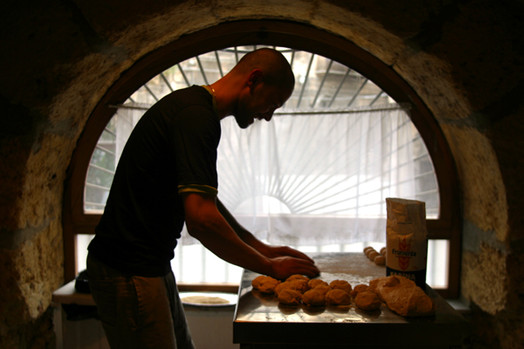
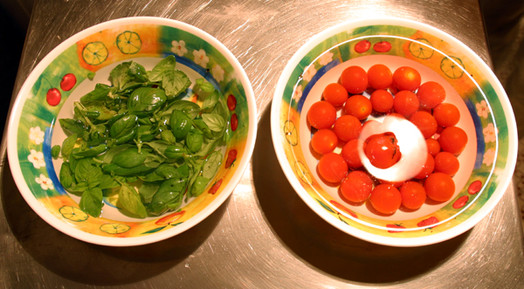
Sunday, April 08, 2007
Giuseppe & Giuseppe
Once a week, the bar downstairs from my flat does little tapas-style appetizers. If you show up at about eight, you can make a meal out of it, paying only for what you drink. It’s not high gastronomy, but good, traditional stuff, and makes for a full house.
Giuseppe, who works at the bar and comes from Trapani (Sicily’s western tip), does all of the cooking. I’m sure he’s paid for his time, but it’s his initiative and he certainly does it more for fun than money.
On Thursday, I gave him a hand in the kitchen, doing everything from rolling out and baking little brioches from dough he made the day before to putting together two pasta dishes. He even made tiny versions of arancini – literally “little oranges” that are classic Sicilian street food - cooked rice balls with any combination of ground beef, tomato sauce, peas, eggs, ham and cheese, the whole thing rolled in fine breadcrumbs and quickly fried.
As most Sicilians who cook still tend to be women, it’s a funny thing for a twenty-something guy to do for fun, but for Giuseppe, that’s part of the connection.
“This is the cooking that my mother and grandmother did,” he says, and clearly he was paying attention as he grew up. For one pasta dish, he’s got tomatoes that have been briefly boiled to loosen their skin, yet he makes the whole sauce separately, cooking button mushrooms, basil, zucchini, red onion, a healthy glug of olive oil, salt, pepper and nutmeg. Only when everything else is cooked does he dice the tomatoes directly into the pot.
“If you cook the tomatoes in the sauce, they lose their flavor,” he says.
He gives the whole thing a stir and sticks his nose in the pot and breathes in deep. “Que odore!” he exclaims in our multi-language mix.
Later, he gets ready to fry the arancini he’s prepped the day before. He’s got a pot on the stove with a couple of inches of oil inside clinking away as it heats up and there’s not a thermometer in sight.
“How do you know when it’s hot enough?” I ask.
“I know.”
“Ah.”
And why cook something so typical at a trendy neighborhood bar?
“Because it’s pleasing. It’s good.” he says, clearly at a bit of a loss for why I’d wonder such a thing. “Why do you eat hot dogs in America? Because they’re good.”
Later, he pulls out a jar of tiny, round red peppers he’s brought for a little work-time snack. They’re stuffed with a mix of classic Sicilian ingredients – capers, tuna and parsley – all soaking in olive oil.
I pop one into my mouth and it dissolves, pushing the corners of my mouth upward in a big, quiet grin.
“They cost a fortune,” he says, “about 12 euros (about $15) for a little pot, but they’re a classic, and they’re orgasmic.”
It looks like the classics will last for at least one more generation.
This is Joe Ray reporting from the Motherland.
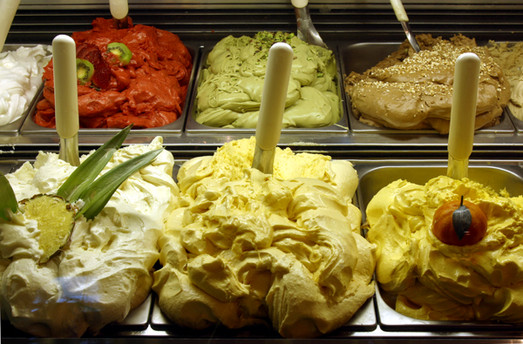
Tuesday, March 27, 2007
Stir 1 day, then chill. Or: The Mother of All Ice Cream Sandwiches
When I arrived in Palermo, the first thing I wanted to do was have a gelato or slushy granita in a brioche. I now know the first one I ate to have been junk.
This weekend, however, I struck gold.
At the end of a Sunday walk, I found a crowd spilling out onto the sidewalk from the Gelateria da Carlo near the train station. I pushed my way in and saw the sign: Brioche Calde con Gelato. “Calde” (hot) was underlined three times, which was all the convincing I needed.
Ticket and pre-paid receipt in hand, I waited for my number (78) to be called. I ordered and the guy pulled a brioche from a plastic bag, halved it (moving the brioche, not the knife for some reason) and filled it with hazelnut and almond gelato. He put the whole thing in what looked like a George Foreman Grill, closed it, and let it work its magic for 14 seconds.
It comes out as a sealed unit that looks like a flying saucer, and the first bite gives you the warmth of the brioche, the cold of the ice cream and the little bit that’s just starting to melt from the heat.
Hoo, dear.
On Saturday, in the town of Cinisi, about a half-hour train ride west of Palermo, I met Santi Palazzolo, a master pastry chef, master chocolatier and ice cream fanatic.
“My grandfather didn’t have machines to make ice cream,” he says, referring back to the Palazzolo pastry shop’s founder. “One guy would turn the basin (which sat in an ultra-cold salted slush mix) with his hands while my grandfather would scrape the ice off the inside,” he said, demonstrating what looked like a ridiculously labor-intensive procedure.
We’ve come a long way.
Palazzolo led the way to the shop’s giant basement laboratory, passing through dedicated pastry and chocolate sections, before stopping in a tiny room with what looked like three stainless steel washing machines: a pasteurizer, an emulsifier and a chiller.
Like the setup at the Padova olive oil mill, it ain’t sexy, but the process yields incredible results.
Palazzolo breaks his gelato into two rough categories: gelato without milk, which are the fruit flavors, and gelato with milk - the ‘nut & bean’ flavors (like vanilla, coffee or hazelnut), with the latter group spending up to a whopping 24 hours in the emulsifier before going into the chiller. Mouthfeel fans and the rest of humanity will find this time well spent.
There are a stack of tricks and techniques like this Palazzolo uses to coax the most flavor from his ingredients, some technical like low-temperature pasteurization, others learned.
“We add lemon juice to that gelato just before refrigerating it (as opposed to all other fruit flavors, where the juice is added at the beginning),” he says. “It gets rid of a metallic taste.”
Back in Palermo, after giving my complete attention to my hot brioche with gelato, I watched the world go by.
Carlo’s is not beautiful. It sits in a building made from what looks like fancy cinder blocks and the inside is lit with blue lights. But it’s overflowing with people of all ages, all enjoying their Sunday treat. Two year old Palermitans, whose chocolate-covered faces would be best cleaned with a mop, mill around with goofy grins. Pre-teen girls, with little rolls of fat spilling out between their layers of fake Dolce & Gabbana clothes, mill around in packs. There are also middle-aged couples, workers on a break, grandparents, and teens on scooters.
It’s horns, Vespas, sunglasses when the sun’s not out, cigarettes, litter, strutting and family. It’s a kid wearing two shades of orange clothes and his dad with the same two shades on his cone. It’s a micro fender-bender and the arm flapping, hunched shoulder discussion that follows and the guy who rides by with a cardboard license plate taped to the fender of his scooter.
Today, hot brioche in hand, I got a big scoop of Palermo.
This is Joe Ray reporting from the Motherland.


Friday, March 23, 2007
Making Oil With The Brothers
The day before I left southern Sicily, Francesco and his brother Sal took me to the mill where they turn olives into oil - the perfect going away present for a food geek like me.
Something of an industrialist’s dream and photographer’s nightmare, the huge space is seemingly filled with nothing but stainless steel machines and white tile.
After Sal’s comprehensive tour, I can now say that I have seen the future, and though it’s not as sexy looking as the past, it tastes better.
“The old way of doing it is much more romantic, but the quality sucks,” said Francesco in his characteristic deadpan.
Two keys to the tourist-worthy ‘old way’ meant crushing the olives in an enormous granite-wheeled mill, then spreading the paste between circular woven mats called fiscola and crushing them in a press to yield the unrefined oil.
Compared with the ‘new way’, the granite mill now seems like a big vat to sneeze into while the olives oxidize and the mats look impossible to clean.
“Now, we can clean the whole system with water pressure,” said Francesco, who demonstrated by pretending to shoot a pair of machine guns from the hip.
The ‘new way,’ which producers were reluctantly getting used to when I was researching an olive oil story in 2002, is much different. Once the olives come into the mill, they are cleaned and de-stemmed and pulverized in two ways in a hammering machine called a frangitore a martelli, before being kneaded into a fine paste in stainless steel vats and passed through a pair of centrifuges.
The system is now a closed and temperature-controlled one where nitrogen is used to prevent oxidation. At the mill, they can even process different oils from different producers at the same time and the whole system is run by a computer.
“I can regulate the whole thing from Rome with my Palm Pilot,” said Sal, though I saved asking why for another day.
“The technology is so advanced here,” he said, gesturing toward the centrifuges, “that most experimentation and research concentrates on the hammers and the kneading.”
The goal of both of these processes is to keep the temperature low. Once the temperature goes up, the flavor leeches out.
The frangitore, for example, now crushes the olives two different ways (instead of one), which saves a couple of degrees. The paste is then pumped into the kneading vats which are held between 78.8 and 80.6 degrees. They’ll mix for no more than 30 minutes, as more than that makes the temperature rise.
The vats are also the first stage where nitrogen comes into play, replacing the air above the vats, in an effort not unlike pouring lemon juice over guacamole or a fresh-cut artichoke.
It seems like a lot of fuss, but as they explain it, modifying the system is the only way to increase quality.
We finish up the tour nibbling their almonds and drinking wine, poured from a giant stainless steel vat.
“Olive oil is not a product that can be modified,” said Sal who goes on to explain that you can mess it up, but you can’t really make it better.
“The difference between wine and olive oil is that you can work on wine in the winery. Olive oil is as it is. You just have to be good in the plant when you transform it.”
This is Joe Ray reporting from the Motherland.
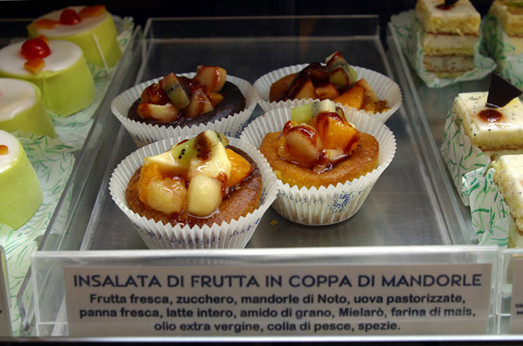
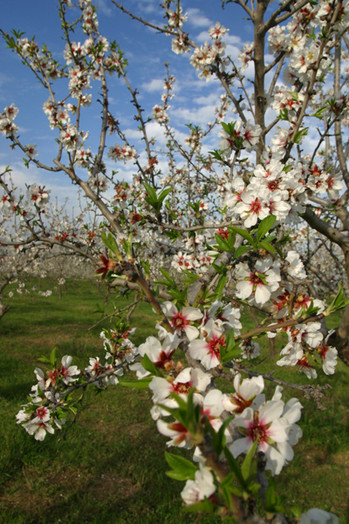
Friday, March 23, 2007
The Four Senses of Corrado Assenza
Talk with enough chefs worth their salt and they’ll almost inevitably take a good hunk of time to preach the virtues of the importance of raw materials.
At an unassuming café in the southern Sicilian town of Noto, pastry master Corrado Assenza dwells on such things for about 20 seconds before he launches into the culinary stratosphere on a gastro-philosophical jag that explains both the primacy of the almond and the overall state of Sicilian pastry making.
Leaving two shot glasses of almond milk in front of Francesco and me, Italy’s 2006 pastry chef of the year walks away, returning only when we’ve finished. He then places a jelly jar of almond cream on the table saying, “This is the base. From this, you can make everything.”
It’s pretty much the first thing he’s said and it’s not terribly clear what ‘everything’ means, but he explains.
Mixed with water, almond cream becomes almond milk. Mixed with a bit of marmalade, it’s the perfect center to a delicate brioche.
“These are the bones,” he says, pointing at the jar on the table while grabbing my knobby wrist and shaking it, “We need bones to make this body.”
‘This body’ is Sicilian pastry as a whole and I feel downright flattered to serve as the example.
“We have about 80 products that we make here and about 30 that use almonds and still others where it’s just to give a bit of the taste.”
Despite more than 1,000 years of Sicilian almond history, in both sweet and savory dishes, Assenza is not sitting around just recreating the classics. His prima case a fumo (“before it became smoke”) is layers of what he calls tobacco cream, cocoa beans, almond and marzipan slices, topped with a strawberry cream. He’s also come up with what he calls insalata di frutta in coppa di mandorle (“fruit salad in an almond cup”), a curious and delicious cousin to strawberry shortcake, where the ingredients of the ‘cup’ include almond flour and olive oil (butter’s a rare bird here).
If this is what the future will be like, visitors to Noto should look forward to getting older in Sicily.
“We have too many ways to apply our tradition. We can copy the past, or use our ability to…interpret it with our eyes, mouth and senses,” he says. “I prefer the second way.”
One of Assenzo’s biggest preoccupations is getting this mix of old and new to the people who might understand or appreciate it the least: tourists and the gastronomically uninterested.
“I remember the when travelers used to come through here in the 60s,” he says, calling the set “Byron Travelers” as they might set up camp in Noto for months at a time.
Now, however, people have morphed into what he refers to – without bitterness – as ‘click and run’ tourists.
So do the lucky ones who happen into Caffe Sicilia get what he’s trying to do?
Disturbingly, he dodges the question a bit, but answers with optimism.
“Now, people arrive with their guide books in hand. I say, ‘Please, close your eyes. Use your ears.’ People aren’t unable to use their senses,” he affirms.
“The key is food. Sweet food.”
Along with their sense of hearing, he says he tries to create a connection to Sicily using color, texture and flavor.
He also uses basil ice cream.
It’s disarming stuff that short circuits your senses, leaving you with only goose bumps and a grin as descriptors.
For Assenzo, basil ice cream and a dreamy almond sorbet – both of which have a minimalist’s ingredient list – are tools to reach ‘click and run’ kids from Sicily and abroad.
“They have other kinds of experience, so you should commence with something special,” he explains with Zen gentillesse. “You need to help them arrive with something simple.”
It isn’t as simple as it sounds to get something like this to work.
“We use technology so we don’t damage the taste of the basil leaves,” he explains. “It took one and a half years to come up with something so we could arrive at this.” In Sicily, where man’s relationship with technology is peculiar at best, this guy is an outright visionary.
So, after discussing his raft of offerings and their philosophical and near-spiritual uses, what’s his favorite dessert?
“It’s the next one. It’s the one I haven’t thought of yet.”
In the meantime, he’ll let his creations be ambassadors of the good stuff to locals and tourists alike.
“Each cake,” he concludes, “is part of a tale that brings you into our land.”
This is Joe Ray reporting from the Motherland.
Thursday, March 22, 2007
Don’t knock it…
Day one in Palermo
MENU
Breakfast: Lemon granite (like a slushy sorbet) on a brioche bun
Lunch: Pane ca meusa – a spleen sandwich
Dinner #1: Foot, udder, tongue and head meat - all cow, served cold - sprinkled with salt and doused with lemon, served on the converted back of a three-wheeled Vespa Ape truck. 500 grams (about a pound), 2 euros (about $2.50).
Dinner #2: Food from Ghana. I yelled over the music, asking if they had a soup with vegetables. I got a stew with huge hunks of liver, lung and tripe in a spicy red sauce, with a huge side of rice. All to be eaten with your hands. It was great. Special note: when a bit of a scuffle broke out by the register, this restaurant also won the prize for the first one where I’ve ever looked for a back door.
Dessert: two Moretti beers while I type.
This is Joe Ray reporting from the Motherland.
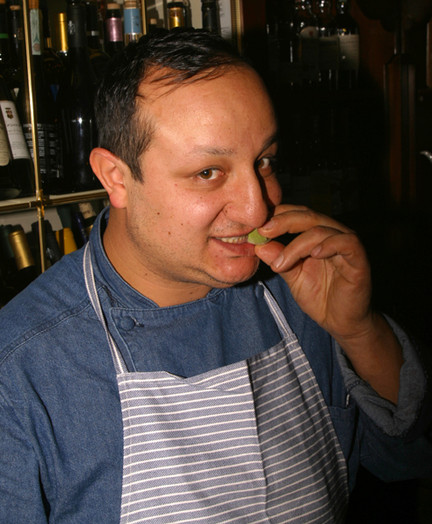
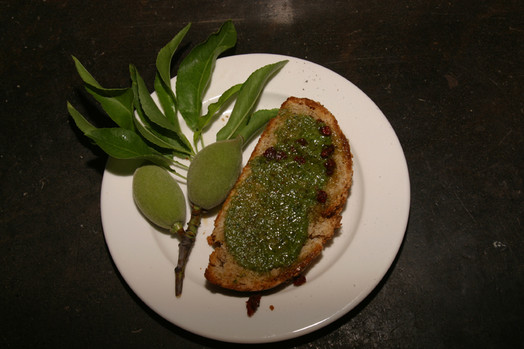
Sunday, March 18, 2007
Spreadable Springtime
Ciccio Sultano looks and acts a like a grown-up version of one the kids from the Sicilian version of “The Little Rascals.” Built like a stubby-fingered butcher who roams the streets in a driver’s cap, he is Sicily’s chef of the moment; his restaurant, Il Duomo, which is only steps away from the real thing in the heart of Ragusa Ibla, has recently been awarded its second Michelin star.
Yesterday, Francesco and I went to see Ciccio to drop off a small crate of green almonds. Right now, they’re a beautiful fuzzy green and, not to mix nuts, but they’re about the size of a walnut right now.
Sultano, who gets his ‘regular’ almonds from Francesco’s family farm, has a bit of an almond fetish.
“I used to steal the green ones as a kid,” he says, flashing his trademark boyish grin. I can understand why; I’ve been known to steal a few from a neighbor’s tree at the edge of Francesco’s family farm. (Is it really stealing if they’re hanging over your friend’s property?)
Green almonds have very peculiar flavors. Right now, the “nut” in the center is white, slightly gelatinous and tastes a bit like cucumber water. The green outside is bitter, a well-loved flavor characteristic here, and quite vegetal, but nibbling one or two in the middle of a field makes for a perfect way to connect with the world around you.
“This isn’t something you sell - It’s for the emotion it gives to people. I give these to people from abroad who don’t know what the real thing is like,” says Sultano. “I just gave one to one of my apprentices – he didn’t believe you could eat it whole.”
“It’s something extraordinary in Sicily,” he says pulling out his menu and opening to the dessert page. “Out of five desserts, three have almonds.”
This makes sense – almonds are a huge crop here and have been for over 1,000 years. They show up in everything from main courses to ice creams, cookies and “pasta reale” - marzipan “fashioned to look like anything but almonds,” writies Robin Goldstein on Fodor’s.com. Today, I saw them shaped to look like apples, sugar cane and…a ham sandwich.
On the non-sweet side, his Sicilian Pesto features almonds and it’s grand stuff.
As an 11 a.m. thank you to Francesco, Sultano lines us up at the bar, slathers up some of his own bread with the bright green goodness, sprinkles salt and a few bits of sun-dried tomatoes over the top, drizzles some olive oil onto it from a great height, then pours three glasses of red wine.
It’s like green, spreadable spring on toast. Wiping the olive oil from my chin, I ask if he’s interested in the almonds health benefits that seem to be all the rage in the United States right now.
â€I don’t care. People in Europe, we don’t go crazy for products for their health qualities,” he says. “The quality of the raw materials is what’s important. To me, presenting products like these is the best way to respect my clients.”
This is Joe Ray reporting from the Motherland.
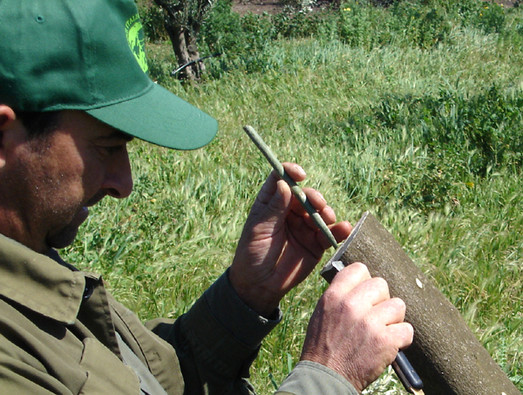

Monday, March 12, 2007
The Road Back To Tradition Begins With A Graft
I was at the farm the other day with Francesco and his brother Salvatore. They were excited about the work two other brothers were doing, grafting olive trees. The goal of the grafting was to turn their carolea olive plants back to Sicily’s native verdese variety, by means of what looks like a brutal process, if you’re a tree.
To my very untrained eye, a tree graft looks like the equivalent of getting your legs chopped off above the knee, then having appendages the size of Barbie doll legs stuck in the stumps and being bandaged up by a grinning doctor who walks away five minutes later, saying you’ll be fine.
In this case, the grafters arrived with a picnic basket worth of olive tree branches, some seriously sharp knives called innestos, a chain saw, a roll of tape and a pack of paper and plastic bags Francesco got from the local baker, and worked their way across the grove, grafting as they went.
Most trees in the grove are a good 12 feet tall with big, beautiful, leaf-covered branches; I’ve taken to using one of them on the top of my hill as an office. The Brothers Graft clearly didn’t share my sentimental attachment to the trees. With two quick cuts of the chainsaw, one of them reduced a tree to a waist-height Y-shaped stump.
A bit shocked and amazed that the leafless, branchless stump could go on living, I asked Francesco how they survive.
“I’d survive,” he deadpanned.
“You’re a tough cookie, my friend,” I replied.
“We’re changing them from carolea plants by grafting verdese shoots,” he continued, not missing a beat.
I ask why they don’t just remove the old trees and plant new verdese plants.
“Buying a verdese plant is outrageously expensive,” he said. “Plus, the (existing) plant is already comfortable with the weather, the soil and all of the microclimatic conditions.”
“So what grows will be 100 percent verdese?”
“Yeah. It’s not a hybrid; it changes the whole identity of the tree.”
If all goes well, three years from now, verdese olives will be growing from these trees.
We walk over and take a closer look. After the limbs are felled, each brother takes a branch above the Y, and using the innestos, they quickly create slots (about two or three per branch of the Y) that they tap the new verdese shoots into. They tightly wrap the top of the stump with packing tape, coat the top with some plastic-y tree protector, cover with a plastic bag to create a greenhouse effect, then the bakery’s paper bags to keep the sun from damaging the tender shoots and move to the next tree.
Somehow, this reminds me of an instant sex change without the estrogen tablets.
“Ah,” said Francesco’s brother Sal, “but these babies will be prettier.”
This is Joe Ray reporting from the Motherland - with special thanks to Francesco for the photos.
